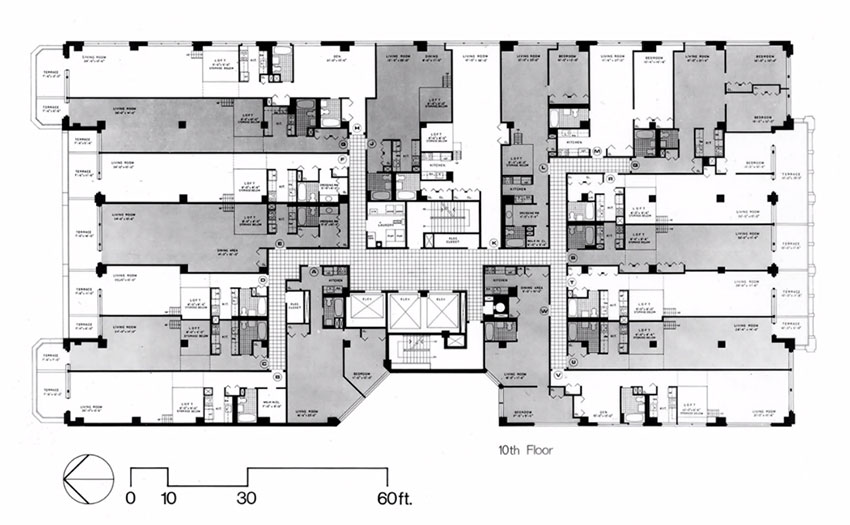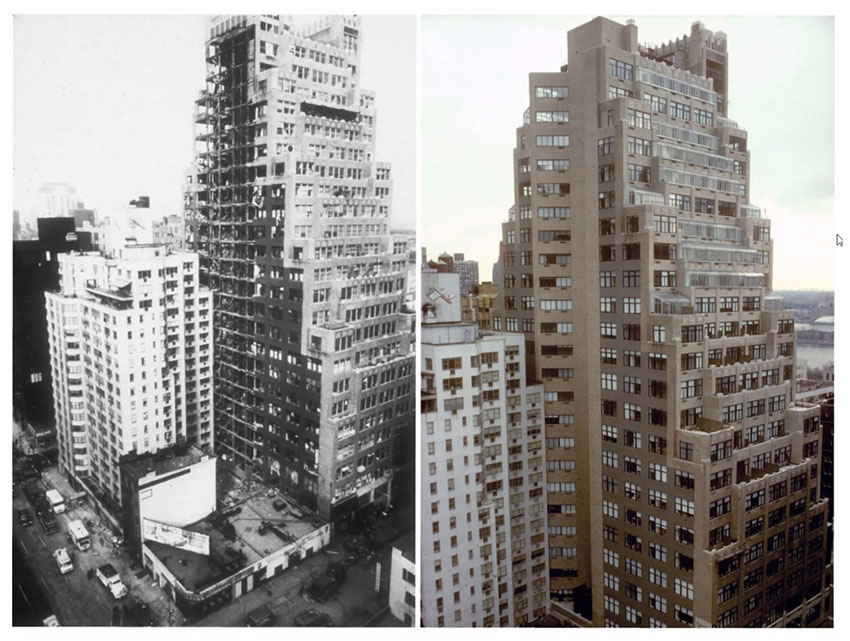Site Selection Criteria for Commercial-to-Residential Conversions
DETAILS TO LOOK FOR, CHANGES TO PREPARE FOR
Floorplate sizes and proportions, ceiling heights, street exposures, mechanical/electrical/plumbing (MEP) infrastructure, and envelope features often vary dramatically between commercial and residential buildings. Zoning customarily separates these uses, except where municipalities have taken explicit steps to combine uses in certain districts; New York City's pattern of conversions, for example, has been shaped by successive rezonings of neighborhoods allowing adaptive reuse, largely in Manhattan below 59th Street after revisions to the Multiple Dwelling Law. Successful conversions, add architects who have worked on or analyzed these projects, have been more common at the higher end of the urban real estate market, as yet doing little to bridge the gap between the societal need for non-luxury housing and the oversupply of office space.
Several years before the pandemic began, the Gensler Research Institute developed a classification for floorplate configurations divided into five archetypes (wedge, cube, light or L-shaped, blinder, and heavy or slight slab), with different potentials for commercial-to-residential conversion based on analysis of sites in the Washington, D.C., central business district (Gilley et al., 2017). The wedge and cube models, this group found, were most conducive to conversion; slabs and L-shapes varied in suitability depending on floorplate depth; “blinders,” in mid-block, lacking openings on side walls, were deemed “logistically complex and financially unsound.” From discussions with clients about pandemic-era priorities, discovering that many developers considered Class C office buildings good candidates for conversion, this firm more recently formulated an internal “office-to-residential calculator dashboard” assigning relative weights to five groups of criteria (site context, 10 percent; building form, 30 percent; floorplate, 30 percent; envelope, 10 percent; servicing, 20 percent) (Gensler, 2022).
Different generations of office buildings offer different possibilities for convertibility, with early-20th-century buildings' fenestration often more conducive to residential adaptation than the towers of the 1960s through 1980s. The latter typically have sealed envelopes with inoperable fenestration, heavy reliance on mechanical ventilation (often dedicating substantial space to MEP systems in vertical shafts and dropped ceilings), and large floorplates. A counterbalancing advantage of nonhistoric buildings, McLane points out, is the flexibility to make exterior improvements, such as adding balconies and rooftop amenities.
“Whether it's a rental building or a condominium, the efficiency of the floorplate and the net rentable or sellable area is really critical,” Cetra comments. “If those numbers look good, that's what's going to make it viable. So you've got to get an efficiency on a typical floor of at least 85 percent, which shouldn't be too difficult to do....You want to get a lease-span dimension that's not so great that it will create a lot of interior space that's not going to be usable and enjoyable to use,” he says, noting that buildings with lease spans up to 40 feet, sometimes slightly higher, are easiest to convert.
Typical residential floorplates with a center double-loaded corridor are around 65 feet wide, allowing apartments up to a 30-foot lease span from corridor to window. With commercial floorplates in the range of 40,000 square feet, or roughly 150 feet by 300 feet, Cetra says, “You have to carve them out to make them work, and when you carve them out, you don't want to lose that floor area, so you've got to put it somewhere. Mostly you put it on top of the existing building, if the building can sustain the additional redistribution of the load. A lot of the buildings from the '60s/'70s were not designed to the same standards for lateral and seismic loading, and so adding onto the buildings can be very, very costly. It usually requires a reinforcement of the structural system.”
One downtown project Cetra's firm is working on, an office building with ample floor area (over a million square feet) and extensive water damage from Hurricane Sandy, provides an example of the degree of renovation a conversion can require. Flooding required elevation of all the electrical equipment. In addition, a code change required the team to raise the ground floor about six feet to be clearly above the flood elevation. To provide natural ventilation and daylight for the apartments being created, the restructured building will have two courtyards carved out, plus an equivalent amount of space added in the form of 10 new stories atop the existing building. “That amount of additional floor area is requiring us to laterally brace the entire structure, so a series of K bracing lines have been designed into the floorplans,” Cetra says, “and the facade needs a lot of work in order to bring it up to current energy code.”
Facades commonly require renovation to improve energy performance and often to provide natural ventilation, which New York City codes and others require for residential use. “A lot of those buildings as well, from a standpoint of energy consumption, don't have high-efficiency exterior walls, and they may not have operable windows,” Cetra notes. “So you're going in and changing the exterior. You may not be ripping it all down, but you're going to improve the energy efficiency. You're going to go from a single-pane window system to at least a double-pane glass and operable windows. So there's an expense there, but I think that's one that's clearly very valuable.” Bafitis adds that, “In almost every case, in conversions that I'm aware of, windows get replaced, so whether they're operable or not is almost irrelevant, because the entire fenestration gets replaced. Now, on a glass office building it becomes tough, but they're so dated and energy-inefficient that I don't see how you convert any of these Midtown office buildings without recladding.” (A previous Architectural Record Continuing Education article, “Adaptive Reuse of Commercial Spaces: Curtain Wall Solutions,” December 2021, addresses facade retrofits in detail.)
A related consideration, Cetra says, is whether a building's MEP systems need replacement. Many candidate buildings have “forced-air cooling systems with the ducts coming from the roofs and going down, and that antiquated system has to be totally ripped out and new high-efficiency systems...put in. And many of these buildings will become all-electric, also, in order to comply with future energy code requirements.” A common condition he has seen in lower Manhattan is for ground floors to be below the flood elevation, with mechanical systems located in the basement; moving those components higher in the building addresses that issue.
Another variable to assess in a candidate building, or to alter in the new design, is the number and position of elevator cores. Residential buildings have lighter elevator requirements than commercial, Cetra says, and in the latter, “usually, the cores are not in the best, most efficient place for conversion. Stairs were placed near the exterior walls so they provided a window into the stairwell, which is no longer required. So you want to move those inboard to take advantage of whatever perimeter you can get...potentially cutting down the number of elevators to a third, depending upon how big the floorplates are and how many units.”
Ceiling heights in older commercial buildings tend to be generous, a plus for post-conversion occupants' quality of life, though from developers' perspective it can be too much of a good thing: 13- to 15-foot ceilings do not maximize rentable space. Such large spaces are also inefficient to heat. Bafitis views 10 to 12 feet as a sweet spot between overscaled ceilings and the 8 to 8½ feet often seen in postwar construction, arguably an artifact of standardized timber lengths and widely regarded as conducive to claustrophobia.
The challenge of a suboptimally configured building can inspire imaginative solutions, not all of which prove feasible. Deep interior spaces in former offices, far from windows, can become dens or home offices. “You could take a large floorplate and you can do a perimeter,” Cetra says. “You use the perimeter for residential, but then you create a different use in the center.”
The obstacles have been effectively surmounted when architects have adequate client support and the opportunity to make strategic alterations. “The big challenge is zoning,” comments Claire Weisz, founding partner of WXY Architecture + Urban Design in New York City. Reconceiving single buildings' programs or combining uses on a civic scale to create “the vertical city,” she says, is “a zoning challenge; it's a financing challenge. But I don't think it's a huge architectural challenge, because actually, in general, commercial buildings are flexible. There's been a huge number of residential conversions, and even some larger ones have come up with clever things like carving courts out in various floors, moving facades back, or doubling the facade so you get an outdoor space.”
Adaptive reuse projects, in general, benefit from the strength-to-weight ratio, construction speed, flexibility, and recyclability of structural steel (see “Weight Watching: Adaptive Reuse with Structural Steel,” Architectural Record Continuing Education, November 2015), a clear advantage when relocating elevator cores, facades, or other components to optimize a commercial building's square footage for residential use.
Weisz’s optimism about these projects is grounded in the contextual details of sustainable urbanism: energy systems, circulation, management of light and airflow. “The world has recognized all-electric as an idea,” she says, “and because of that, I think architecture can be more flexible. You're worried less about gas lines in buildings. We've had our exiting and egress laws that are not so dissimilar between office buildings and residential,” with certain nuanced exceptions (e.g., in New York City, scissor stairs are allowed in residential buildings but not commercial buildings). The challenge, she believes, is not so much to shoehorn new uses into fixed spaces as to create projects that convince “policymakers, planners, and communities why flexible conversions, and being able to actually have even office space and residential space in the same building, might be a good way to go....Adapting buildings that already exist is the challenge of our time.”











